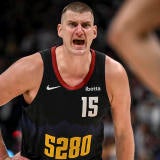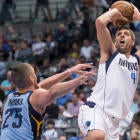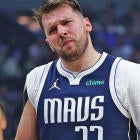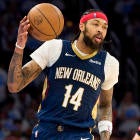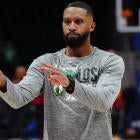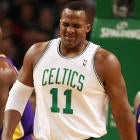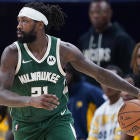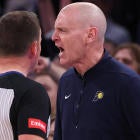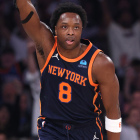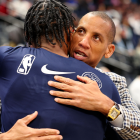The traditional big has essentially become obsolete in the NBA today. If you don't have an efficient jump shot -- preferably from 3-point range -- the likelihood of becoming a valuable asset to a team is decreasing by each season. Look at Clint Capela, for instance. Just two years ago he signed a five year, $90 million contract with the Houston Rockets, and was loved for his rim-running ability alongside James Harden. He's efficient in the paint (63.4 percent), but his value outside of the restricted area on offense is minimal. He doesn't provide floor spacing, which was a problem considering Russell Westbrook is most effective when he's attacking the rim, and he doesn't have a jump shot. So, Houston shipped him out to the Atlanta Hawks and bought into playing small ball, using P.J. Tucker as their starting center who shoots 37 percent from deep.
In recent years, big men have had to diversify their game in order to extend their careers, but before the 3-point frenzy in the NBA, there were a handful of power forwards and centers who were ahead of the curve and were originators of the shooting big man. Some were strictly 3-point specialists who made a career living beyond the arc. Others were all-around shooters, who are regarded as some of the best pure shooters in NBA history. Whichever side they fall on, though, these 10 players were sinking 3s and mid-range jumpers before it became the norm for guys 6-10 or taller.
Dirk Nowitzki
- Years played: 1999-2019
- Career averages: 20.7 PPG, 47.1 FG%, 38.0 3P%, 87.9 FT%, 3.4 3PA/G
Nowitzki entered the NBA as a lanky 7-footer who struggled to match up with other physical bigs in the league. But he left it as a guaranteed first-ballot Hall of Famer, who broke the mold for what power forwards were supposed to be with his sweet shooting touch that extended all the way out the 3-point line. His unorthodox shooting form -- specifically his fadeaway jumper -- is a shot that players like Kevin Durant and LeBron James implement in their games today. Nowitzki's height, mixed with the off-balance nature of his shot made it nearly impossible to block, and is one of the most unguardable shots in NBA history.
In five of Nowitzki's 21 years in the NBA, he shot above 40 percent from 3-point range, including his MVP season in 2006-07 where he became the first power forward to join the 50-40-90 club. it's not just Nowitzki's 3-point shooting that makes him one of the 15 greatest shooters in NBA history. His mid-range game was just as impressive. His pick-and-pop game with Steve Nash early in his career was formidable, and resulted in countless buckets. While he wasn't the most skilled ballhandler, he could hit a defender with an occasional crossover to pull up for a jumper.
For most of his career, Nowitzki's style of play was considered out of the norm, compared to what a traditional power forward was expected to do. He wasn't a typical post-up and rebound big, but he was a matchup nightmare for opposing teams. Now, though, seeing a 7-footer pull up from deep is expected, and Nowitzki was the catalyst in bringing that change.
Peja Stojakovic
- Years played: 1999-2011
- Career averages: 17.0 PPG, 45.0 FG%, 40.1 3P%, 89.5 FT%, 5.5 3PA/G
If we're talking pure shooters, Stojakovic isn't just one of the best bigs to do it, he's one of the best shooters in NBA history. His offensive game was never as diverse as Nowitzki's, however, Stojakovic was one of the best 3-point shooters in the early-2000s. Positionally, Stojakovic was a small forward for his entire career, but the fact that he was 6-10 and had a career 3-point shooting percentage of 40.1 percent is absurd. He never lost his shooting touch throughout his entire career, and in his final season where he played with the Dallas Mavericks, his hot hand proved to be crucial in Game 3 of the Western Conference semifinals against the Los Angeles Lakers.
Stojakovic scored 11 points in the fourth quarter, and combined for 20 points with Nowitzki to lead a comeback against the Lakers and take a commanding 3-0 series lead. Stojakovic knocked down four 3s, including a momentum-shifting 3-pointer to start a 17-5 run by the Mavericks to end the game. It wasn't out of the ordinary for Stojakovic to turn it up a notch when the postseason came around. When he was a member of the New Orleans Hornets in 2007-08, he shot a ridiculous 54.9 percent from beyond the arc, while helping lead the Hornets to the Western Conference semifinals.
Chris Bosh
- Years played: 2004-2016
- Career averages: 19.2 PPG, 49.4 FG%, 33.5 3P%, 79.9 FT%, 1.0 3PA/G
If it weren't for a blood clotting condition that forced Bosh to retire, he would likely still be able to find a spot on a number of rosters around the league today due to his sweet shooting touch. His mid-range shots would significantly decrease, while his 3-point attempts would skyrocket, but that wouldn't be an issue, because in his final two seasons he shot north of 35 percent from deep. In the first half of his career with the Raptors, where he was the star of the show in Toronto, Bosh was facing up opponents from 18 feet out, hitting them with a jab step then dribble into a stepback jumper.
He had the shot and lift of an athletic guard, in the body of a 6-11 center who could still hammer it home and finish through contact at the rim. When he got to Miami, though, he made sacrifices for the greater good of the team to help win two championships, but even with fewer touches, he was still nailing over 50 percent of his mid-range shots. It wasn't until his final two years with the Heat, after LeBron James returned to Cleveland, that Bosh really started to lean into taking more 3s.
In his final year in the NBA, he was attempting a career-high 4.2 shots from beyond the arc a game, and hitting them at a 36.5 percent clip. That earned him the opportunity to compete in the Three-Point Contest at All-Star Weekend during the 2015-16 season, but a calf strain kept him from participating. If Bosh were able to keep playing and develop his 3-point shot even more, he would've been a highly sought after player in the league. He retired when he was 31, so if it weren't for the blood clotting condition, he probably had a lot still left in the tank.
Arvydas Sabonis
- Years played: 1996-03
- Career averages: 12.0 PPG, 50.0 FG%, 32.8 3P%, 78.6 FT%, 0.9 3PA/G
What's most important to remember about Sabonis' career, is that he didn't come to the NBA until he was 31 years old. By then, he already had a lengthy career in Europe where he averaged 20 points a game, while shooting 54.8 percent from the field and 38.4 percent from beyond the arc on about two attempts per game. When he got the NBA, 7-foot centers rarely attempted shots outside of the paint, much less from 3-point territory, so Sabonis was somewhat of a unicorn in his playing days with the Blazers.
While his 3-point shooting in the NBA wasn't what it was overseas (32.8 percent), he still shot 50 percent from the field in seven seasons in Portland. In his first few seasons most of his shots came around the rim, as the Blazers made the most of his 7-3 stature, but as he continued to knock down mid-range jumpers, he was given more freedom to step outside the paint. In doing so, he would draw out centers like Shaquille O'Neal who were in unchartered territory guarding someone of that size that far out from the basket. More often than not, Sabonis would make defenders pay for giving him so much room to get his shot off.
Detlef Schrempf
- Years played: 1986-2001
- Career averages: 13.9 PPG, 49.1 FG%, 38.4 3P%, 80.3 FT%, 1.1 3PA/G
Guys like Nowitzki idolized Schrempf when he was in the league. In fact, when Nowitzki retired in 2019, Schrempf was one of his five childhood heroes that flew in and honored him at his final game in Dallas. Schrempf was a master of the turnaround mid-range jumper, and was a threat on every team he played for. In back-to-back seasons, he earned Sixth Man of the Year honors, while averaging 16.7 points and shooting 52.8 percent from the field and 34.2 percent from 3-point range. He never was a high-volume 3-point shooter, even in seasons where he was starting he was only putting up two 3-point attempts a night. However, his shooting from beyond the arc was always an extra tool in his arsenal that often caught teams by surprise that this 6-10 forward, who could move and handle the ball like a guard, was pulling up from deep.
When defenders would step out and guard him on the wing, he'd get them to bite on a pump fake, and that's when he had them right where he wanted them. From there he could either pull up for the 3-pointer, dribble in and hit a mid-range shot, or attack the rim for a floater. What's comical about all this, though, is that Schrempf's scoring arguably wasn't the best part about his game. He had elite court vision which helped him pull off ridiculous behind-the-back passes on the break or while being double teamed. In his era, someone of his size doing that was unheard of, but Schrempf was a skilled passer just as he was a great shooter.
Mehmet Okur
- Years played: 2003-2012
- Stats: 13.5 PPG, 45.8 FG%, 37.5 3P%, 79.7 FT%, 2.5 3PA/G
While injuries slowed Okur down significantly toward the end of his career, when he was at his peak, his 3-point touch was dangerous. When he was in Detroit, he was a backup center on a championship Pistons team with Ben Wallace as the starter. When Okur would come into the game, he would knock down the occasional 3-pointer, or pull up from mid-range, showing us that he wasn't the traditional post-up center who was incapable of scoring outside of the paint. Little did Detroit know, Okur would go on to be a big man with significantly more upside on the offensive side of the ball than Wallace because of his shooting.
When Okur signed with Utah, he was shooting the ball far more and was even named an All-Star in the 2006-07 season. He owned shooting averages of 46.2 percent from the field, and 38.4 percent from deep all while averaging 17.6 points a night. During the mid-2000s, the Jazz had a consistently competitive squad led by Deron Williams, Carlos Boozer and Andre Kirilenko, with Okur acting as the fourth scorer on that team.
Okur provided floor spacing and open lanes to the rim for Boozer and Williams, and was one of the reasons the Jazz ranked No. 1 in the league in the 2007-08 season in offensive efficiency (112.1). However, an Achilles injury in the first game of the 2010 Western Conference playoffs limited him significantly in his final two seasons in the league, so much so that he only played in 30 games after that injury.
Terry Mills
- Years played: 1991-2001
- Career averages: 10.6 PPG, 45.7 FG%, 38.4 3P%, 78.1 FT%, 2.0 3PA/G
Like others on this list, Mills' 3-point shooting wasn't unleashed until later in his career, and it was mainly because during the 1994-95 season the league decided to shorten the 3-point line to address a decrease in scoring around the NBA. Mills ended up hitting 38.2 percent on 3s that season, while averaging four attempts per game. For the next three seasons with the shortened 3-point line, he averaged 40.4 percent from deep. Read into that what you will, but Mills was already a skilled shooter from inside the arc, and while he did benefit from a closer 3-point line which inflated his stats, he still had to knock them down, and it was only a foot difference anyway.
When the 3-point line was moved back after the 1996-97 season, Mills was still efficient from deep, as he shot 39.3 percent from beyond the arc on three attempts a game in the 1999-00 season. By then, though, he was on the tail end of his career. Mills was one of the originators of the stretch four position that's so prominent in today's game, and retired after 10 years in the league as one of the sweetest shooting bigs in NBA history.
Rasheed Wallace
- Years played: 1996-2013
- Career averages: 14.4 PPG, 46.7 FG%, 33.6 3P%, 72.1 FT%, 2.9 3PA/G
Perhaps one of the most athletic players on this list, Wallace was a ferocious dunker, but he was also one of the most skilled shooting bigs during his era. Early in his career, he operated mainly in the mid-range, using a variety of moves to create space between himself and the defender, but in the middle of his career, he started shooting 3s, and was knocking them down with ease. He finished his career shooting 33.6 percent from deep, but if you take out the first six seasons of his career, where he was only attempting a single 3-pointer per game, then his career average jumps to 34.2 percent on four attempts per game.
His mid-range shooting was his specialty, though. During the 2005-06 season in which he was named an All-Star, Wallace connected on nearly 50 percent of his mid-range jumpers, knocking down long 2s, and sinking fadeaway jumpers from the top of the key. His shooting efficiency declined as he got older, but at his peak, Sheed was a gifted shooter for his size.
Channing Frye
- Years played: 2006-2019
- Career averages: 8.7 PPG, 44.0 FG%, 38.8 3P%, 82.2 FT%, 3.0 3PA/G
Frye has perhaps the smoothest jump shot of any 7-footer in NBA history and was a consistent catch-and-shoot threat for most of his career. During his peak in Phoenix, he was knocking down 3s at a 38.9 percent clip, and is the prototype for what NBA teams want out of bigs today. While he was never the star on any team, his defensive presence in the post, mixed with his specialist shooting skills made him an essential cog on the Cleveland Cavaliers 2016 championship squad. He shot over 50 percent from deep during the Cavs title run, including an absurd 27-point outing in the Eastern Conference semifinals where he went 7 of 9 from downtown, including 11 fourth-quarter points.
Frye benefited greatly from playing alongside some of the greatest passers in NBA history, with Steve Nash in Phoenix and LeBron James in Cleveland, and he consistently fulfilled his role of being a spot-up shooter. He retired as one of only two 7-footers in the league to knock down over 1,000 shots from beyond the arc, the other one being Nowitzki.
Matt Bonner
- Years played: 2005-2016
- Career averages: 5.8 PPG, 46.4 FG%, 41.4 3P%, 78.0 FT%, 2.4 3PA/G
Nicknamed the "Red Mamba" by none other than Kobe Bryant, Bonner built up a reputation as being a lights out shooter from long range over his 12-year career. Despite his shooting form resembling what an Olympic shot putter would look like before launching a heavy ball, Bonner still connected on 3s at a ridiculously high clip. He led the league in 3-point percentage during the 2010-11 season (45.7 percent), and his 41.5 career percentage ranks in the top 20 in NBA history. He ranks third in Spurs franchise history in effective field goal percentage (57.1 percent), and was the ultimate floor spacer on two championship rosters in San Antonio in 2007 and 2014.
Surprisingly, despite his ability to knock down shot after shot from deep, Bonner only shot 78 percent from the free throw line. If it weren't for his average free throw percentage, he likely could've put up multiple 50-40-90 seasons, as he hovered around those numbers several times in his career.










